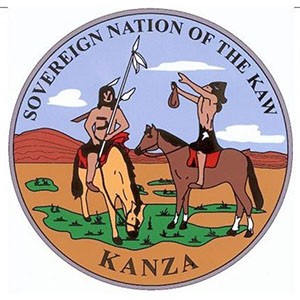Kaw Nation
By Alex Baron

By 1888, a tribe that had once numbered in the thousands would be reduced to about 190 surviving individuals who endured forced removal, disease, starvation and unfair land treaties.
The Kaw Nation began its history with 20 million acres in northern and eastern present-day Kansas and hunting grounds throughout the state.
The Europeans referred to them as the Kanza or Kansa people. Like all tribes, the Kaw Nation faced the oppressions of westward expansion, and their control of Kansas would lead to action by the U.S. government.
According to the Kaw Nation website, “A succession of treaties sought to change the Kaw from an independent, semi-sedentary people into individual family farmers on the model of white agricultural society.”
The first of the treaties was signed in 1825 and moved the Kaw to a much smaller, 30-mile wide reservation in what would become Topeka.
Between 1825 and 1846, the Kaw Nation’s population was severely reduced due to disease and wrongdoing by new settlers in the territory. The land treaties presented to the Kaw Nation were consistently dismissed and disregarded, leading to another forced move to a 250,000-acre plot of land with an 1846 treaty.
Then, the land treaty of 1852 further reduced the Kaw Nation’s land to 80,000 acres. On this plot of land, families were placed on separate 40-acre plots in an attempt to reduce the community through forced separation. The final forced removal occurred in 1872, when the tribe was sent to present-day Oklahoma.
At one point the Kaw Nation was reduced to only 194 people. Education about their history and culture and how education would lead to a rebirth of the nation became critical for Kaw citizens, a tribal historian said.
“The cultural side is what grounds us to where we come from...even though we are all Oklahomans we are still connected to our people and our land,” said Dwight Pickering, director of American Indian education for the Kaw Nation.
Education has become such a critical aspect of Kaw life because it has been the only way to stay connected to the tribe’s culture and history as well as to fight tyranny and rebuild the nation, Pickering said. Now, the goal is bigger than educating tribal members -- the Kaw Nation wants to educate the state of Oklahoma, he said.
The Kaw believe that interconnectivity between the tribes and the general population is critical for an improved society overall, Pickering said.
Pickering said he has been working with the Oklahoma Department of Education to “support a Native history course attached to Oklahoma history.” The proposal is intended to give more focus to all tribes and expand the education of Oklahoma students to understand all concepts of Native life.
Pickering believes this can be done with a Native history book with 39 chapters, for each of the 39 recognized tribes.Each chapter would include the history of each of the tribes and information about tribal jurisdictions and how each government developed and existed.
Pickering said the Kaw Nation worked with other tribes to provide tribal consultation guides to public school districts in an effort to have tribes and schools work together to help all students.
The Kaw Nation has rebuilt to more than 3,500 citizens, overcoming hardship and oppression and using education to develop hospitals, schools, entrepreneurs and politicians.
Alex Baron is a reporter with Gaylord News, a reporting project of the University of Oklahoma Gaylord College of Journalism and Mass Communication.

